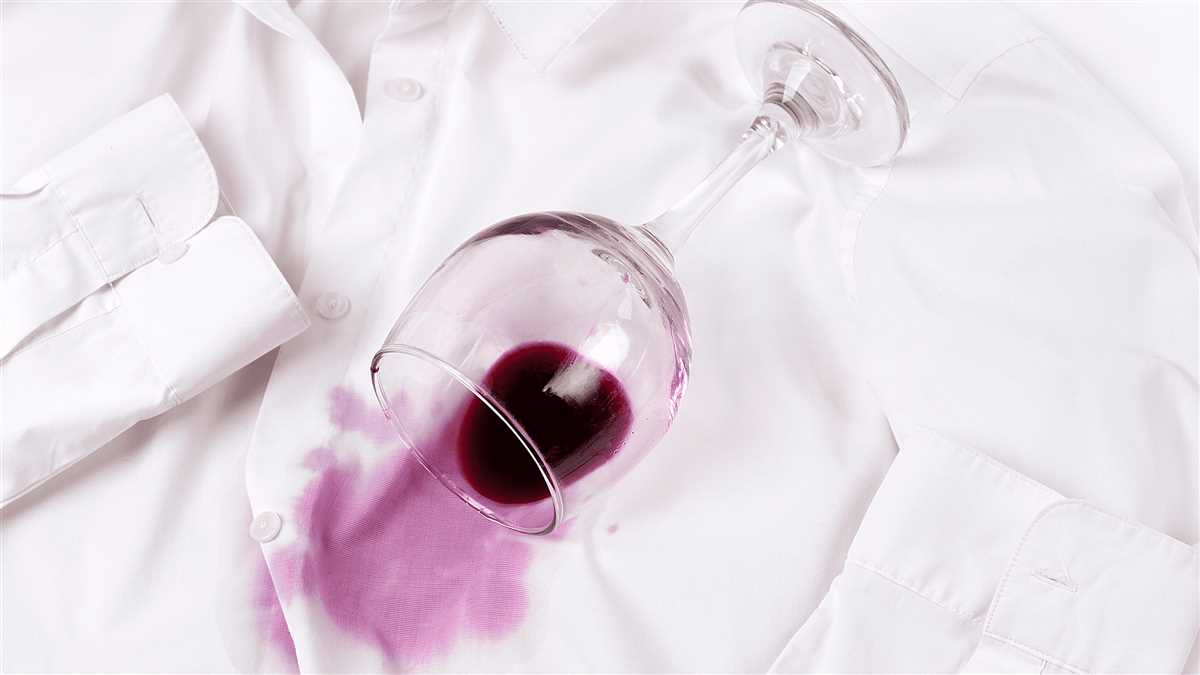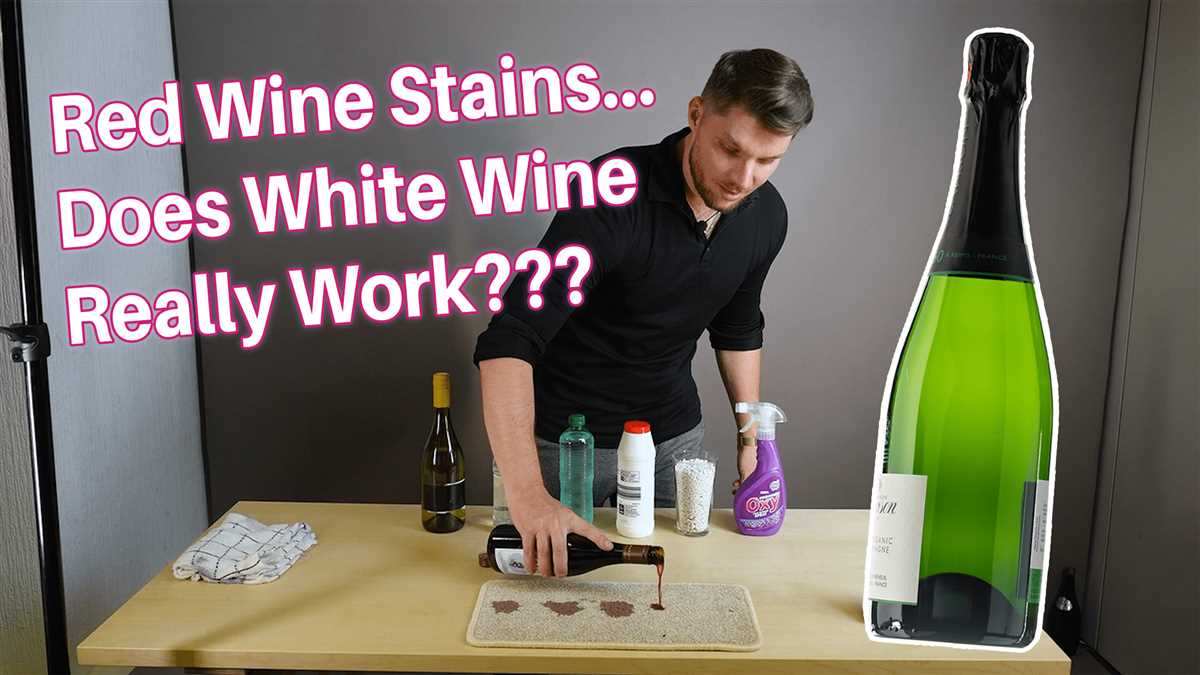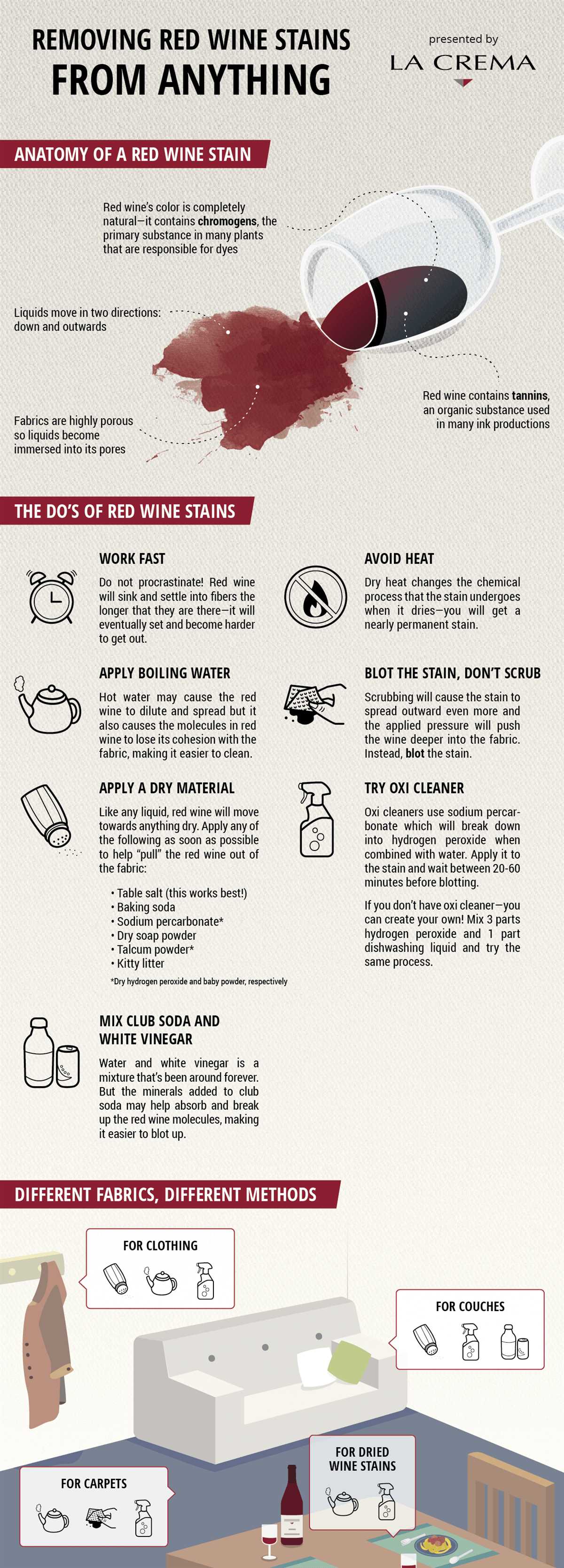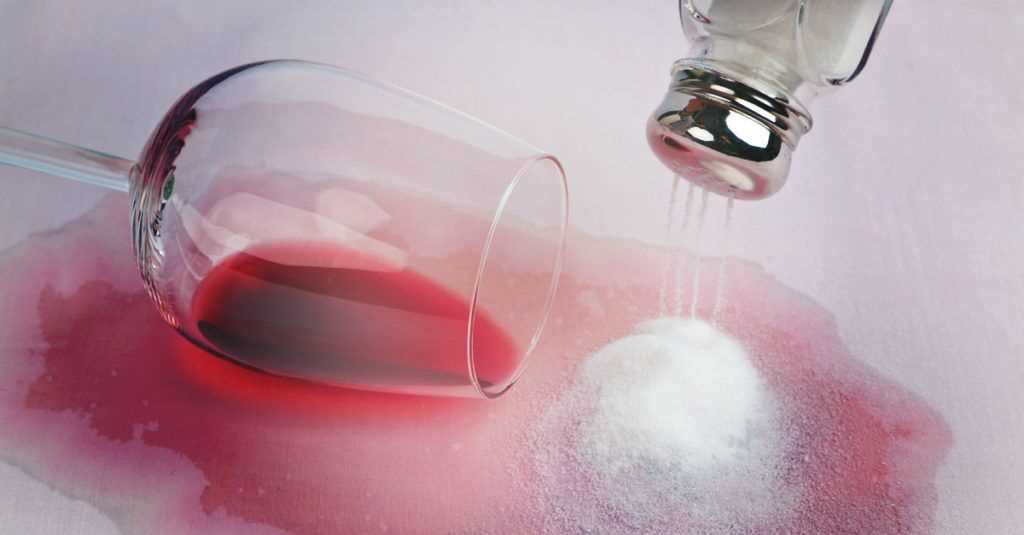




Red wine stains can be a nightmare to deal with. Whether it’s on your favorite white blouse or your brand new carpet, the deep red color seems impossible to remove. But have you ever heard the old wives’ tale that white wine can actually remove red wine stains? Is there any truth to this popular belief?
Contrary to what you may think, white wine can actually help remove red wine stains. The logic behind this is that the acid in white wine can neutralize the pigments in red wine, making it easier to lift the stain from the fabric or surface. This is similar to the way that vinegar or lemon juice can be used to remove stains. But does it really work?
While white wine can be effective in some cases, it is not a guarantee that it will completely remove the red wine stain. It may help to lighten the stain and make it less noticeable, but for more stubborn stains, you may need to try other stain removal methods. It’s also important to note that using white wine on delicate fabrics or surfaces may cause damage, so it’s always best to test it on a small, inconspicuous area first.
In conclusion, white wine can help remove red wine stains to some extent, but it may not completely eliminate the stain. It’s always best to act quickly when dealing with a red wine stain, blotting the excess wine and then applying a stain remover or other cleaning method. And remember, prevention is better than cure, so try to avoid spilling red wine in the first place!
Can White Wine Remove Red Wine Stains?

It may sound counterintuitive, but white wine can actually help remove red wine stains. When red wine is spilled on fabric or carpet, the color from the red wine molecules binds with the fibers of the material, creating a stubborn stain. White wine contains acids that can help break down the red wine pigments and make them easier to remove.
Here is a step-by-step guide on how to use white wine to remove red wine stains:
- Blot the stain with a clean cloth or paper towel to remove any excess liquid. Do not rub the stain, as this may spread it.
- Pour a small amount of white wine over the stain, making sure to completely saturate the affected area. The white wine will start to dilute the red wine pigments.
- Gently blot the stain with a clean cloth or sponge. The white wine will help lift the red wine stain from the fabric or carpet.
- Repeat steps 2 and 3 until the stain is no longer visible. It may take several applications to completely remove the stain.
- Once the stain is gone, rinse the area with cool water and blot dry with a clean cloth. This will help remove any residual white wine and prevent it from leaving a sticky residue.
It is important to note that white wine may not be effective on older or set-in red wine stains. In these cases, it is recommended to consult a professional cleaner or try other stain removal methods.
Using white wine to remove red wine stains is a popular and widely-used method, but it is not guaranteed to work in all situations. It is always a good idea to test the white wine on a small, inconspicuous area of the fabric or carpet before applying it to the stain.
| Pros | Cons |
|---|---|
| White wine is easily accessible and affordable. | It may not work on older or set-in stains. |
| The acid in white wine can help break down red wine pigments. | It may not be effective on all types of fabric or carpet. |
| It is a natural alternative to harsh chemical stain removers. | It may cause discoloration or damage to certain materials. |
In conclusion, white wine can be a useful tool in removing red wine stains. However, its effectiveness may vary depending on the age and type of stain, as well as the material it has stained. It is always recommended to test any stain removal method on a small, inconspicuous area before applying it to the stain.
The Myth: Using White Wine to Remove Red Wine Stains
One of the most popular myths when it comes to removing red wine stains is the idea that white wine can help effectively remove the stain. This myth has been passed on for generations, with many believing that the acidity and alcohol content of white wine can somehow counteract the red wine stain and make it disappear.
However, the truth is that using white wine to remove red wine stains is nothing more than a myth. While it may seem counterintuitive, pouring white wine on a red wine stain can actually make the situation worse and cause the stain to spread.
The reason behind this is the pH levels of the two wines. Red wine has a lower pH level than white wine, which means it is more acidic. When white wine is poured on a red wine stain, the acidity of the white wine can react with the acidity of the red wine and exacerbate the stain.
Furthermore, the alcohol content of white wine is not strong enough to break down the pigments in red wine stains. The alcohol in white wine is dilute compared to other cleaning agents, making it ineffective in removing stubborn stains.
Instead of relying on white wine to remove red wine stains, it’s best to act quickly and follow a few proven techniques. First, blot the stain with a clean cloth or paper towel to absorb as much of the wine as possible. Avoid rubbing, as this can push the stain deeper into the fabric.
Next, create a cleaning solution by mixing warm water with a small amount of dish soap or laundry detergent. Gently dab this solution onto the stain using a cloth, sponge, or soft brush. Rinse with cool water and repeat if necessary.
If the stain persists, consider using a commercial stain remover or consulting a professional cleaner who specializes in removing tough stains.
In conclusion, the myth of using white wine to remove red wine stains is just that – a myth. It’s important to rely on proven cleaning techniques and products to effectively remove red wine stains rather than using white wine, which can potentially make the stain worse.
The Science Behind Wine Stains
When it comes to removing red wine stains, many people turn to white wine as a possible solution. But does white wine really have the power to remove those pesky red wine stains? Let’s dive into the science behind wine stains and find out.
The Components of Red Wine
To understand why red wine stains are so stubborn, we first need to take a closer look at the components of red wine. Red wine contains a variety of molecules that contribute to its color and flavor, including tannins, anthocyanins, and alcohol.
Tannins are responsible for the astringent taste in red wine and are also known for their staining properties. These molecules have the ability to bind to proteins and other substances, causing them to become insoluble and difficult to remove.
Anthocyanins, on the other hand, are responsible for the red color of wine. These pigments are water-soluble and can easily be absorbed by fabrics, leaving behind visible stains.
The Role of White Wine
White wine is often suggested as a remedy for red wine stains due to its acidity and alcohol content. It is believed that these properties can help break down the tannin molecules and lift the stain from the fabric.
However, the effectiveness of white wine in removing red wine stains is limited. While the acidity and alcohol content may help to some extent, they are not strong enough to completely remove the stains on their own. White wine may only provide a temporary solution by diluting the stain and making it less noticeable.
Other Methods for Red Wine Stain Removal
If you’re dealing with a stubborn red wine stain, there are other methods you can try besides using white wine. One common method is to blot the stain with a clean cloth or paper towel to absorb as much of the wine as possible. Then, you can apply a stain remover or a mixture of dish soap and hydrogen peroxide to the stain and gently scrub it with a brush. Finally, rinse the fabric with cold water and launder as usual.
It’s important to act quickly when dealing with red wine stains, as the longer the stain sits, the more difficult it becomes to remove. Additionally, it’s always a good idea to test any stain removal method on a small, inconspicuous area of the fabric before applying it to the stain directly.
| Method | Description |
|---|---|
| White Wine | May temporarily dilute the stain, but not strong enough to completely remove it. |
| Blotting | Remove excess wine by gently blotting the stain with a clean cloth or paper towel. |
| Stain Remover | Apply a commercial stain remover or a mixture of dish soap and hydrogen peroxide to the stain and scrub gently. |
| Rinsing and Laundering | Rinse the fabric with cold water and launder as usual. |
While white wine may not be the magical solution for removing red wine stains, understanding the science behind wine stains can help you choose the most effective method for tackling these stubborn marks. With the right approach and a little bit of patience, you can successfully remove red wine stains and restore your fabrics to their original state.
The Truth About Using White Wine
When it comes to removing red wine stains, there is a common myth that white wine can do the trick. However, the truth is that using white wine to remove red wine stains might not be as effective as you think.
1. The Science Behind Stains
In order to understand why using white wine does not always work, it is important to understand the science behind stains. Red wine contains a pigment called anthocyanin, which is responsible for its vibrant color. When red wine is spilled on a fabric or carpet, the anthocyanin molecules bind with the fibers and create a stain.
2. The Myth of White Wine
The myth of using white wine to remove red wine stains likely originated from the belief that the alcohol content in white wine can dissolve the pigments in red wine. However, white wine does not contain enough alcohol to effectively break down the anthocyanin molecules.
3. The Potential Risks
While using white wine might not remove the red wine stain completely, it can actually make the stain worse in some cases. The sugars and acids present in white wine can further set the red wine stain into the fabric or carpet, making it more difficult to remove.
4. The Recommended Technique
Instead of relying on white wine, there are more effective stain removal techniques that you can use. First, blot the stained area gently with a clean cloth to absorb as much of the red wine as possible. Then, mix a solution of dishwashing liquid and water, and carefully dab it onto the stain. Blot the area with a clean cloth and repeat the process until the stain is no longer visible.
If the stain persists, consider using a commercial stain remover specifically designed for red wine stains. Always remember to follow the instructions on the product and conduct a patch test on a small, inconspicuous area before applying it to the stained fabric or carpet.
5. Prevention is Key
While it’s good to know how to remove red wine stains, it’s even better to prevent them from happening in the first place. If you are hosting a party or enjoying a glass of red wine at home, be sure to handle it with care. Avoid placing your glass near the edge of a table or counter, and consider using spill-proof wine glasses or coasters.
By taking preventative measures, and knowing the right techniques to remove red wine stains, you can ensure that your favorite white tablecloth or carpet remains stain-free.
Alternative Methods for Removing Red Wine Stains
If you find yourself with a red wine stain and don’t have white wine on hand, don’t worry! There are several alternative methods for removing red wine stains that you can try.
1. Salt
One common household item that can help remove red wine stains is salt. Simply sprinkle a generous amount of salt onto the stain while it is still wet. The salt will absorb the liquid and help lift the stain from the fabric. Let it sit for a few minutes and then blot the area with a clean cloth or paper towel. Repeat if necessary until the stain is gone.
2. Club Soda

Another popular alternative method is to use club soda. Pour some club soda onto the stain and gently blot it with a clean cloth. The carbonation in the club soda can help break up the stain and lift it from the fabric. Continue to blot the area until the stain is no longer visible.
3. Vinegar and Dish Soap

If you have vinegar and dish soap on hand, you can create a DIY stain remover. Mix equal parts white vinegar and dish soap together and dab the mixture onto the stain. Gently scrub the stain with a soft brush or cloth and let it sit for a few minutes. Rinse with cold water and repeat if necessary.
4. Hydrogen Peroxide

For tougher red wine stains, you can try using hydrogen peroxide. Apply a small amount of hydrogen peroxide onto the stain and let it sit for a few minutes. Blot the area with a clean cloth and rinse with cold water. Be cautious when using hydrogen peroxide on colored fabrics, as it may cause fading.
5. Commercial Stain Removers
If all else fails, you can always turn to commercial stain removers. There are many products available on the market specifically designed to remove tough stains like red wine. Follow the instructions on the packaging and be sure to test the product on a small, inconspicuous area of the fabric first to ensure it does not cause any damage.
Remember, the key to successfully removing red wine stains is to act quickly and blot the stain before it sets. These alternative methods can help in a pinch, but prevention is always the best approach. Enjoy your glass of wine responsibly, and if a spill happens, you’ll know exactly what to do!
Preventing Red Wine Stains in the First Place
While white wine can be used to remove red wine stains, it’s always better to prevent the stains from happening in the first place. Here are some tips to help you prevent red wine stains:
1. Act quickly
When a red wine spill happens, it’s essential to act quickly. The longer the stain sits, the harder it will be to remove. Grab a cloth or paper towel and blot the area as soon as possible to absorb as much wine as you can.
2. Use salt
Sprinkling salt on a fresh wine spill can help absorb the excess liquid and prevent it from seeping deeper into the fabric. The salt will also help to lift some of the wine stain, making it easier to remove later.
3. Avoid rubbing
One common mistake when dealing with a red wine spill is rubbing the stain vigorously. This can actually spread the wine and make the stain worse. Instead, gently blot the area to absorb the wine without spreading it further.
4. Use cold water
When rinsing the wine stain, always use cold water. Hot water can set the stain and make it more challenging to remove. Rinse the stained area under cold running water, directing the flow from the back of the fabric to push the wine out.
5. Apply a stain remover
If the red wine stain persists, apply a stain remover specifically designed for wine stains. Follow the instructions on the product and be sure to test it on a small, inconspicuous area of the fabric before applying it to the stain.
6. Consider preventive measures
To further prevent red wine stains, you can consider using stain-resistant fabrics or treating your upholstery and carpets with a stain repellent. These measures can help make any future wine spills easier to clean up.
By following these preventive measures, you can reduce the chances of encountering stubborn red wine stains and enjoy your wine without worry.
FAQ
Can white wine remove red wine stains?
Many people believe that white wine can remove red wine stains. However, this is not entirely true. While white wine can help dilute the red wine stain and make it less noticeable, it does not completely remove the stain.
How does white wine help with red wine stains?
White wine helps with red wine stains by acting as a neutralizer. When white wine is poured onto a red wine stain, it helps to dilute the color of the stain and makes it less visible. However, it is important to note that white wine does not completely remove the red wine stain.
What is the best way to remove red wine stains?
The best way to remove red wine stains is to act quickly and blot the stain immediately with a clean cloth or paper towel. It is important not to rub the stain, as it can spread and set into the fabric. After blotting the stain, you can use a stain remover or a mixture of dish soap and hydrogen peroxide to treat the stain. It is always recommended to test the stain remover on a small, inconspicuous area of the fabric before applying it to the entire stain.
Can baking soda be used to remove red wine stains?
Yes, baking soda can be used to remove red wine stains. After blotting the stain with a clean cloth or paper towel, you can sprinkle baking soda over the stain and let it sit for a few minutes. Then, use a damp cloth to gently blot the stain, working from the outside towards the center. Repeat this process until the stain is removed. Baking soda can help absorb the red wine and lift it from the fabric.











